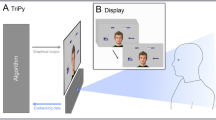Abstract
Children with ASD have difficulty with social communication, particularly joint attention. Interaction in a virtual environment (VE) may be a means for both understanding these difficulties and addressing them. It is first necessary to discover how this population interacts with virtual characters, and whether they can follow joint attention cues in a VE. This paper describes a study in which 32 children with ASD used the ECHOES VE to assist a virtual character in selecting objects by following the character’s gaze and/or pointing. Both accuracy and reaction time data suggest that children were able to successfully complete the task, and qualitative data further suggests that most children perceived the character as an intentional being with relevant, mutually directed behaviour.
Access this chapter
Tax calculation will be finalised at checkout
Purchases are for personal use only
Preview
Unable to display preview. Download preview PDF.
Similar content being viewed by others
References
DSM-IV, A.P.A.T.F.: DSM-IV: Diagnostic and statistical manual of mental disorders. American Psychiatric Association, Washington, DC (1994)
Rajendran, G., Mitchell, P.: Text Chat as a Tool for Referential Questioning in Asperger Syndrome. J. of Speech, Language, and Hearing Research 49, 102–112 (2006)
Schmidt, C., Schmidt, M.: Three-dimensional virtual learning environments for mediating social skills acquisition among individuals with autism spectrum disorders. In: IDC 2008: Proceedings of the 7th International Conference on Interaction Design and Children, pp. 85–88. ACM, New York (2008)
Parsons, S., Mitchell, P., Leonard, A.: The use and understanding of virtual environments by adolescents with autistic spectrum disorders. Journal of Autism and Developmental Disorders 34(4), 449–466 (2004)
Tartaro, A., Cassell, J.: Playing with virtual peers: bootstrapping contingent discourse in children with autism. In: ICLS 2008: Proceedings of the 8th International Conference for the Learning Sciences, pp. 382–389. International Society of the Learning Sciences (2008)
Foster, M., Avramides, K., Bernardini, S., Chen, J., Frauenberger, C., Lemon, O., Porayska-Pomsta, K.: Supporting Children’s Social Communication Skills through Interactive Narratives with Virtual Characters. In: Proc. of the ACM Multimedia Conference (2010)
Goldman, A., Vignemont, F.: Is social cognition embodied? Trends in Cognitive Sciences 13(4), 154–159 (2009)
Porayska-Pomsta, K., Bernardini, S., Rajendran, G.: Embodiment as a means for Scaffolding Young Children’s Social Skill Acquisition. In: Proc. IDC 2009 (2009)
Porayska-Pomsta, K., Frauenberger, C., Pain, H., Rajendran, G., Smith, T.J., Menzies, R., Foster, M.E., Alcorn, A., Wass, S., Bernadini, S., Avramides, K., Keay-Bright, W., Chen, J., Waller, A., Guldberg, K., Good, J., Lemon, O.: Developing Technology for Autism: an interdisciplinary approach. Personal and Ubiquitious Computing (in press)
Sigman, M., Ruskin, E.: Continuity and change in the social competence of children with autism, Down syndrome, and developmental delays. Wiley-Blackwell, Malden (1999)
Charman, T.: Why is joint attention a pivotal skill in autism? Philosophical Transactions: Biological Sciences 358, 315–324 (2003)
Behne, T., Carpenter, M., Tomasello, M.: One-year-olds comprehend the communicative intentions behind gestures in a hiding game. Developmental Science 8(6), 492–499 (2005)
Pellicano, E., Macrae, C.N.: Mutual eye gaze facilitates person categorization for typically developing children, but not for children with autism. Psychonomic Bulletin & Review 16(6), 1094–1099 (2009)
Tomasello, M., Carpenter, M., Liszkowski, U.: A new look at infant pointing. Child Development 78(3), 705–722 (2007)
Lord, C., Rutter, M., DiLavore, D., Risi, S.: Autism Diagnostic Observation Schedule (ADOS). Western Psychological Services, Los Angeles (1999)
Author information
Authors and Affiliations
Editor information
Editors and Affiliations
Rights and permissions
Copyright information
© 2011 Springer-Verlag Berlin Heidelberg
About this paper
Cite this paper
Alcorn, A. et al. (2011). Social Communication between Virtual Characters and Children with Autism. In: Biswas, G., Bull, S., Kay, J., Mitrovic, A. (eds) Artificial Intelligence in Education. AIED 2011. Lecture Notes in Computer Science(), vol 6738. Springer, Berlin, Heidelberg. https://doi.org/10.1007/978-3-642-21869-9_4
Download citation
DOI: https://doi.org/10.1007/978-3-642-21869-9_4
Publisher Name: Springer, Berlin, Heidelberg
Print ISBN: 978-3-642-21868-2
Online ISBN: 978-3-642-21869-9
eBook Packages: Computer ScienceComputer Science (R0)




